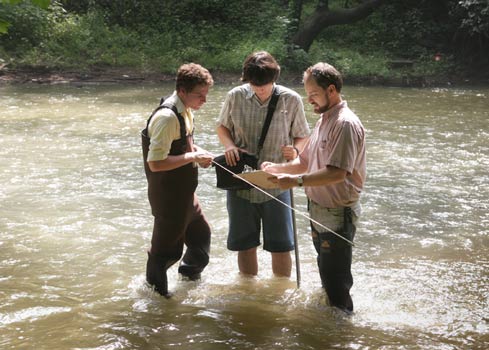Lafayette students and faculty monitor the health of the Bushkill Creek and the region draining into it through field laboratories, class projects, and EXCEL Scholars research. This past fall, Arthur Kney, assistant professor of civil and environmental engineering, and Dru Germanoski, Dr. Ervin R. VanArtsdalen ’35 Professor and head of geology and environmental geosciences, led students in monitoring projects.
As part of Introduction to Environmental Engineering, 28 students assessed the Bushkill’s water quality in several lab sessions. Kney and David Brandes, assistant professor of civil and environmental engineering, teach the course alternately. Brandes suggested using the Bushkill as a common thread throughout the class.
“By focusing on the Bushkill watershed, students are able to better identify with class material because of the ‘hands-on’ approach,” says Kney. “Data gathered by the class is used by the Bushkill Stream Conservancy to help evaluate trends in water quality, thereby providing valuable research, free of charge, directly to the community.”
A watershed is a region draining into a river, river system, or other body of water.
Eleven students in Germanoski’s Hydrogeology class measured stream flow at two locations and determined that there was a significant loss of surface water through seepage into groundwater. The class also evaluated groundwater in the watershed’s slate and carbonate rock portions to learn how bedrock geology affects water chemistry.
“It makes [students] aware that no matter where they are on earth, they are always in a watershed that is part of successively larger watersheds,” Germanoski explains. “Whatever land-use practices are occurring in one place have the potential to affect distant places through natural hydrological linkages. The students have personal experience with road closure and sociopolitical issues associated with sinkhole development in the Lehigh Valley, and the situation in the Bushkill watershed is emblematic of those issues.”
This past semester, civil engineering majors Hugo R.J. Sindelar ’08 (Houston, Texas), Ryan Clark ’08 (Sellersville, Pa.), and David Kendall ’08 (Lebanon, Pa.) worked with Kney and Steven Mylon, assistant professor of chemistry, to study why the lower parts of the watershed are not as pristine as the upper portions. The team used bottom-dwelling insects called benthic macroinvertebrates as indicators of overall stream health and combined the new information with chemistry data from the past five years.
“I have learned how much work goes into a simple assessment of stream health; my group spent many weekends in the field and lab gathering and analyzing data,” says Sindelar. “I also did real research that the local community can use to assess what measures they want to take to improve the water quality in their watershed.”
Mark Battaglia ’06 (Wallingford, Pa.), Dan O’Neil ’06 (Lincoln, R.I.), and Fred Lott ’06 (Galloway, N.J.) downloaded data and maintained probes until Hurricane Ivan destroyed nearly all of their gauges. The civil engineering majors then focused on retrieving the lost gauges and placing them in new locations. O’Neil and Lott also collaborated with Brandes on EXCEL research to determine how urban development contributes to severe flooding.
“I enjoyed the field work aspect of the project, and it made me more interested in hydrology,” says Lott, who plans to study the subject in graduate school. “It’s great getting outside and jumping in a stream as ‘work.’”

Daniel O’Neil ’06 (left) and Frederic Lott ’06 researched changes in storm-water runoff in the Bushkill Creek watershed as EXCEL Scholars working with David Brandes, assistant professor of civil and environmental engineering (right).
